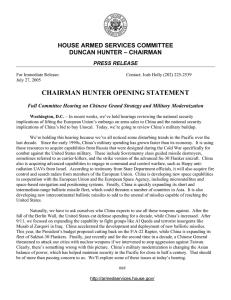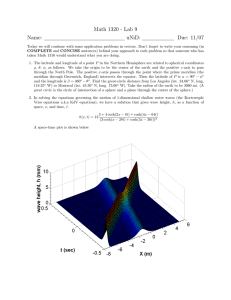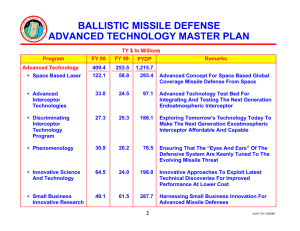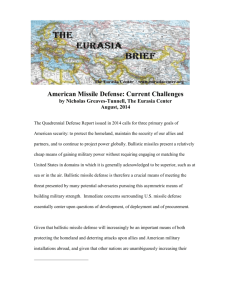INTRODUCTION THE GROWING IMPORTANCE OF BALLISTIC MISSILE DEFENSE
advertisement
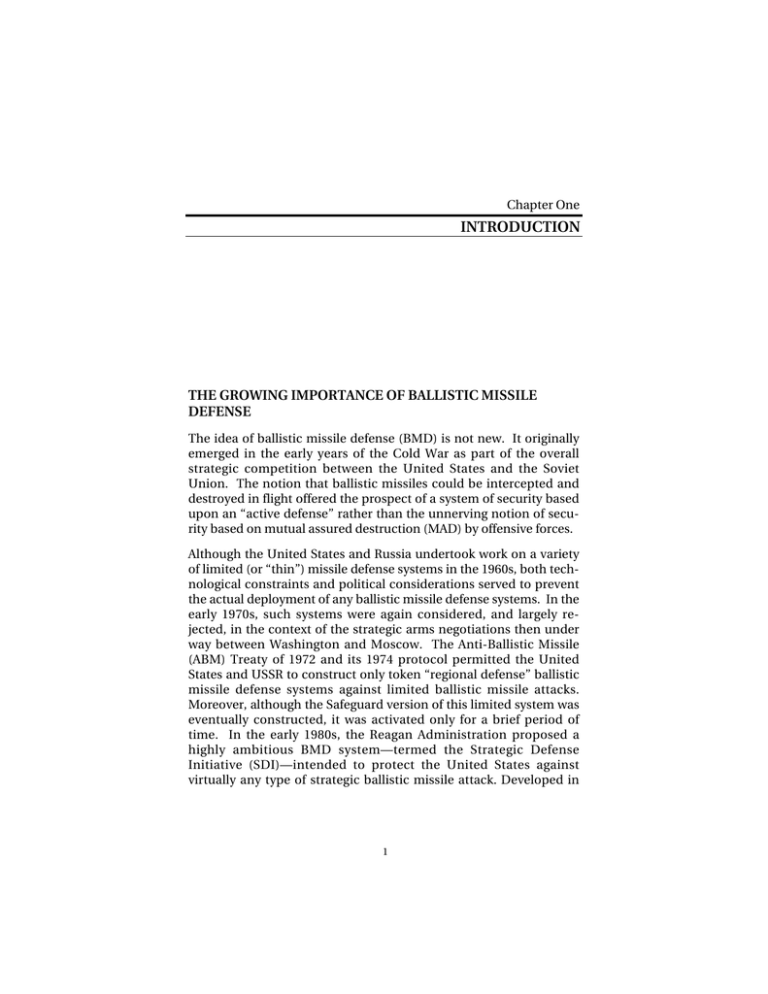
Chapter One INTRODUCTION THE GROWING IMPORTANCE OF BALLISTIC MISSILE DEFENSE The idea of ballistic missile defense (BMD) is not new. It originally emerged in the early years of the Cold War as part of the overall strategic competition between the United States and the Soviet Union. The notion that ballistic missiles could be intercepted and destroyed in flight offered the prospect of a system of security based upon an “active defense” rather than the unnerving notion of security based on mutual assured destruction (MAD) by offensive forces. Although the United States and Russia undertook work on a variety of limited (or “thin”) missile defense systems in the 1960s, both technological constraints and political considerations served to prevent the actual deployment of any ballistic missile defense systems. In the early 1970s, such systems were again considered, and largely rejected, in the context of the strategic arms negotiations then under way between Washington and Moscow. The Anti-Ballistic Missile (ABM) Treaty of 1972 and its 1974 protocol permitted the United States and USSR to construct only token “regional defense” ballistic missile defense systems against limited ballistic missile attacks. Moreover, although the Safeguard version of this limited system was eventually constructed, it was activated only for a brief period of time. In the early 1980s, the Reagan Administration proposed a highly ambitious BMD system—termed the Strategic Defense Initiative (SDI)—intended to protect the United States against virtually any type of strategic ballistic missile attack. Developed in 1 2 Japan and Ballistic Missile Defense response to both technological advances and a strong desire to render nuclear weapons “impotent and obsolete,” SDI generated significant outlays of financial and other research and development (R&D)–related resources. Nonetheless, it did not result in the deployment of an actual system, in large part because of its excessive cost, technological uncertainties, and potentially adverse impact on arms control negotiations with the Soviet Union. The subsequent collapse of the Soviet Union in the early 1990s ended efforts to implement the SDI program. The apparent attractiveness of ballistic missile defense systems has been on the rise since the early 1990s. The 1991 Persian Gulf War bolstered interest in theater missile defense (TMD) systems designed to protect U.S. forces and allies overseas. Moreover, at least seven factors, linked to both increasing missile threats separate from the past Soviet-American strategic competition and the growing technological feasibility of possible missile countermeasures, caused the reemergence of serious interest in national missile defense (NMD) in the United States in the mid-1990s. First and foremost, the spread of advanced military technology over the past ten years has made it possible for a growing number of countries to acquire, by indigenous production or importation, basic ballistic missile systems and matching conventional and unconventional warheads, including weapons of mass destruction (WMD)— chemical, biological, and possibly nuclear weapons. Second, of perhaps greatest concern, these missile-related capabilities are being developed or acquired by specific “countries of concern” to the United States, such as North Korea, Iran, Iraq, and Libya. Even the possibility of ballistic missile use by such states could severely complicate U.S. and allied decisionmaking during future crises, especially if such missiles are WMD-armed. Third, the danger posed by such developments to U.S. forward-based forces, allies, and friends was demonstrated by Iraq’s use of shortrange ballistic missiles against United Nations (UN) coalition forces during the 1991 Gulf War and by North Korea’s development of medium-range ballistic missiles in the 1990s. Moreover, the potential danger posed to the United States was at least suggested by Introduction 3 Pyongyang’s subsequent efforts to develop a long-range missile capable of striking U.S. territory. Fourth, the development of ballistic missile technology by countries with financial and political incentives to export has further accelerated the proliferation of ballistic missile systems, technologies, and components in recent years. For some observers, the increased availability of ballistic missile technology on the world market has arguably increased the chance that both larger numbers of states and even nonstate actors (such as terrorist organizations) might acquire ballistic missiles in the near to medium term. Fifth, the breakup of the former Soviet Union, Russia’s ongoing, severe economic malaise and resulting internal political and social unrest, and the concomitant deterioration of Russia’s armed forces have increased the possibility of an accidental or “rogue” launch of long-range ballistic missiles deployed on the territory of the former Soviet Union. Sixth, in the Asia-Pacific region, the potential dangers posed by North Korea’s growing ballistic-missile and WMD capabilities are compounded by the modernization and expansion of China’s ballistic missile force, including larger numbers of more capable short-, medium-, and possibly even long-range missiles. This development is of particular concern given growing tensions over the Taiwan issue and China’s use of short-range ballistic missiles during the Taiwan Strait crisis of 1995–1996. Seventh, during the past 15 years, significant advances have occurred in some of the technologies required to construct at least a limited ballistic missile defense system and its accompanying supporting infrastructure, including sensors, rocket motors, radars, and guidance systems. Moreover, the potential technological feasibility of ballistic missile defenses was suggested, if not proven, by the use of Patriot air defense missiles during the Gulf War to defend against Iraqi ballistic missiles. Although Patriot missiles were relatively ineffective overall, a few might have managed to hit their targets and thus for the first time demonstrated the potential strategic utility of BMD systems. However, it could be argued that the real strategic value of the Patriot (and perhaps subsequent systems) was that the promise of a defense kept the coalition together. 4 Japan and Ballistic Missile Defense Taken as a whole, these factors have greatly increased incentives in the United States to research, develop, and possibly deploy both theater and national missile defense systems. In the aftermath of the Persian Gulf War, President George Bush supported a scaled-back version of President Reagan’s Strategic Defense Initiative known as Global Protection Against Limited Strikes (GPALS). Although primarily designed as a national missile defense system, GPALS had a TMD underlayer. In 1993, President Clinton deemphasized the NMD component of the system in response to the arguments that proliferation of short- and medium–range ballistic missiles posed a greater threat to U.S. forward-based forces. However, since at least early 2000, the United States has increased its relative emphasis on NMD development, largely in response to growing concerns over North Korea’s long-range missile development program. THE RELEVANCE OF BMD SYSTEMS TO JAPAN Potential Benefits According to proponents, the deployment of a BMD system to protect Japanese citizens and military forces offers several potential benefits. First, such a system could significantly strengthen Japan’s ability to counter the above-mentioned emergent ballistic missile threats. In particular, Japan is potentially vulnerable to missile attacks or threats from North Korea in the context of a Korean conflict, and perhaps from China in the context of a military crisis over Taiwan.1 In both instances, Japan could be targeted either as a result of its use as a nearby base area for U.S. forces or because of its direct involvement in such crises. The potential threat from North Korea gained considerable salience for the Japanese when Pyongyang fired a Taepodong (TPD) missile over northern Japan in 1998 (discussed below), although most analysts agree that the greater threat to Japan comes from North Korea’s shorter-range Nodong missiles. Japan might also be vulnerable to accidental or unauthorized missile ______________ 1 Urayama (p. 616) concluded on the basis of interviews with Japanese politicians, security experts, and government officials that China’s use of short-range ballistic missiles in 1995–1996 to intimidate Taiwan “. . . left a big scar on Japan’s security psyche and led many Japanese to doubt the credibility of China’s no-first-use pledge” regarding nuclear weapons. Introduction 5 attacks from the states of the former Soviet Union, or missile attacks/threats from terrorists. Although the latter threat seems unlikely, some observers believe that Asian animosities toward Japan stemming from World War II make this a scenario that defense strategists should at least not ignore. Second, a BMD system might strengthen the credibility of the U.S. defense commitment to Japan2 and improve political cooperation and military coordination between Tokyo and Washington. An effective BMD system capable of offering significant protection to both U.S. forces in Japan and Japanese citizens would arguably reduce the chance that limited conventional or even WMD ballistic missile threats might erode the willingness of the United States to defend or support Japan in a crisis or might more generally impair U.S. force effectiveness in East Asia.3 Conversely, such a system might also strengthen the willingness of Japan to support the United States in a potential military crisis. On a narrower level, an effective BMD system would also likely encourage improvements in bilateral defense doctrine, the integration of battle management/command, control, and communications (BM/C3) systems between the two armed forces, and the general interoperability of U.S. and Japanese military units. If effectively managed, it could also enhance the overall level of political trust and cooperation existing between the United States and Japan. Third, an extensive Japanese BMD system would also most likely compel the modernization and integration of Japan’s self-defense forces in critical areas, especially regarding C3 infrastructure. The construction of a multilayered system with components managed by ______________ 2The credibility of America’s defense commitment to Japan has become a more open subject of discussion among Japanese security specialists and Self-Defense Force officers in recent years. This has occurred as part of a larger trend toward more permissive defense politics and an overall greater willingness to discuss national security strategy and deterrence issues. Such greater openness has emerged as a result of generational change, declining expectations in the efficacy of the use by Japan of economic tools in security policy, frustration with Japan’s passive diplomacy of the past, and consequent efforts to assume greater defense responsibilities in the context of the U.S.-Japan alliance and to modernize the Japanese military. We are indebted to Michael Green for this observation. Also see Green and Dalton, p. 16. 3On the other hand, some observers believe that a fairly robust Japanese BMD system might actually reduce the U.S. willingness to defend Japan in a missile crisis by shifting missile defense responsibilities to Tokyo. 6 Japan and Ballistic Missile Defense all three services would arguably require major conceptual, organizational, and procedural revisions to facilitate greater interservice compatibility between Japan’s air, ground, and maritime self-defense forces. It would also likely augment the roles and capabilities of specific services, and could serve to enhance the relatively low prestige currently accorded the military within Japanese society. Fourth, a Japanese BMD system might also facilitate the acquisition of sophisticated technologies and industrial capabilities, such as software and systems integration and missile technology, that would be of significant use to both the self-defense forces and private industry. The indigenous development or acquisition of these and other technologies and development processes could strengthen Japan’s ability to adopt a more independent defense posture, should the need arise. Such technologies and processes might also strengthen Japan’s overall defense industrial base, benefit ailing defense industry corporations, or generate significant spin-off advantages to Japan’s commercial sector. The cooperative development and technology sharing required could also benefit both the Japanese self-defense forces and the private sector by leading to the relaxation of Japan’s stringent arms export controls, thereby expanding the market and reducing the costs of defense-related technologies. Fifth, a workable, mobile sea- or land-based BMD capability could constitute an important Japanese contribution to future UN peacekeeping or humanitarian efforts. Such a capability would permit Japan to contribute materially to UN operations without having to contemplate the highly controversial option of placing significant numbers of Japanese troops on the ground.4 Such a contribution would almost certainly help to avoid the recurrence of international tensions over Japan’s contribution that emerged during the Gulf War. Finally, Japanese participation in a successful BMD program might contribute to a reduction in the global and regional proliferation of ballistic missiles and related technologies. Japan strongly supports ______________ 4 This is not to deny that even the deployment of a mobile BMD system in a UN operation would likely be unacceptable to many Japanese. Introduction 7 global arms control and counterproliferation efforts. By demonstrating that ballistic missile defense is both technologically feasible and financially affordable, those who seek to acquire or transfer ballistic missiles or ballistic missile technologies might conclude that their efforts are worthless and wasteful. 5 Potential Problems At the same time, the development and deployment of a BMD system in Japan poses certain significant potential military, political, and economic problems or dangers. If mishandled, it could severely weaken the U.S.-Japan alliance by undermining Japanese confidence in the United States’ political credibility or in the reliability of the U.S. military deterrent, and by creating division and dissent between the two countries over such issues as cost-, technology-, and intelligence-sharing; the interoperability of U.S. and Japanese forces and command and control facilities; and the conditions under which a Japan-based BMD system might be activated. Second, the likely huge cost of any effective BMD system could deprive Japan’s armed services of sufficient funds to acquire other important military systems, forcing very difficult trade-offs. Moreover, the deployed systems could prove to be inadequate or largely incapable of dealing with the most serious missile threats confronting Japan, thus resulting in both huge financial waste and significant domestic political conflict, especially if the Japanese public were to perceive Japan’s BMD systems as being largely ineffective. Third, the deployment of a BMD system could generate significant legal problems, e.g., by possibly violating Japanese laws prohibiting the military use of space and the export of military-related items, as well as foreign agreements of importance to Japan such as the ABM Treaty and the Missile Technology Control Regime (MTCR). BMD systems could also undermine the general goals of the international ______________ 5 Several of the above points are drawn from Theater Missile Defenses in the AsiaPacific Region, A Henry L. Stimson Center Working Group Report, Report No. 34, June 2000, Washington, D.C., pp. 63–68 (hereafter, “Stimson Report”). 8 Japan and Ballistic Missile Defense arms control effort. Japan has become a major supporter of this effort in the last decade.6 Fourth, a Japanese BMD system would likely aggravate Japan’s relations with China and North Korea and possibly prompt one or both countries to increase the size and sophistication of their missile forces capable of reaching Japan. Fifth, an extensive BMD system under Japanese control could increase fears among some Asian nations that Tokyo would use such a system to strengthen its offensive military capabilities, e.g., in the area of offensive missiles, and more generally to greatly improve its overall defense industrial base. 7 Given such potential positive and negative consequences, it is clear that Japan’s future policies regarding ballistic missile defense will exert a significant influence on Japan’s relations with her neighbors, Japanese domestic politics, and, of greatest importance, the U.S.Japan alliance. Indeed, the decisions that Japan makes in this area could fundamentally alter the character and structure of the alliance, of Japan’s military forces, and of the relationship between the Japanese military and Japanese society. PURPOSE OF THE STUDY This study seeks to identify and examine in some detail the many factors influencing Japan’s approach to the issue of ballistic missile defense, including the perceptions, motives, and interests of key Japanese players, the role of the United States, the Japanese decisionmaking process regarding BMD issues, and the dynamics of critical considerations such as alliance maintenance, cost, feasibility, commercial and legal factors, political or bureaucratic competition, and the reaction of the People’s Republic of China. The purpose of this examination is to assess the pros and cons of various options available to Japan in handling the BMD issue, to identify the most likely course(s) of Japan’s future BMD development, and to discern ______________ 6As Green and Dalton state (p. 19): “If TMD, or more likely NMD, causes disruption or unraveling of the WMD and missile control regimes, Japan will find its defense policies at odds with its arms control idealism.” 7Green and Dalton, pp. 68–71. Introduction 9 the possible implications of such development for the U.S.-Japan alliance and Asian stability. In pursuing these subjects, this study will endeavor to address such questions as the following: What is the specific nature of the ballistic missile threat confronting Japan, both at present and in the foreseeable future? What types of countermeasures are available to Japan and, of these countermeasures, which would probably be the most prudent and effective against what specific threats? To what extent and in what manner has the United States influenced the Japanese stance toward ballistic missile defense? How has Japan responded thus far to the ballistic missile threat and U.S. efforts to elicit Japanese participation in a BMD system? What are the likely future milestones that Japan will confront in grappling with the issue of ballistic missile defense? Which major Japanese leaders and organizations will most influence future BMD decisions and in what manner? How are such issues as alliance maintenance, cost, feasibility, commercial incentives, and Chinese behavior evaluated and handled by key Japanese actors? What is the relative importance of these issues to Japanese decisionmakers? And finally, what implications does the preceding pose for the future of the U.S.-Japan alliance? STRUCTURE OF THE STUDY The remainder of the study is divided into three chapters. Chapter Two examines the two major factors motivating Japan’s involvement in ballistic missile defense: the threat to Japan posed by ballistic missiles, and the position and behavior of the United States. The chapter also identifies the range of specific countermeasures and responses available to Japan to defend against ballistic missile threats, summarizes the main policies and actions undertaken thus far by Japan in the area of ballistic missile defense, and identifies several future milestones and likely next steps. Chapter Three identifies the major Japanese individuals and organizations influencing future decisions on BMD and assesses their views and interests. The chapter also assesses how such issues as alliance maintenance, cost, feasibility, commercial incentives, and Chinese behavior are addressed by key players and the relative importance of each issue in the decisionmaking process. 10 Japan and Ballistic Missile Defense Chapter Four provides general conclusions, assesses the overall implications of the preceding analysis for the U.S.-Japan alliance, and offers some policy recommendations.

